DNA Barcoding of Black Flies (Diptera: Simuliidae) in Slovakia and Its Utility for Species Identification
Abstract
1. Introduction
2. Material and Methods
3. Results
3.1. Genetic Distances
3.2. Phylogenetic Trees
3.3. Assignment to Barcode Index Numbers (BINs)
4. Discussion
4.1. Prosimulium, Hirtipes Group
4.2. Subgenus Boophtora
4.3. Subgenus Eusimulium
4.4. Subgenus Nevermannia, Vernum Group
4.5. Subgenus Simulium, Argenteostriatum Group
4.6. Subgenus Simulium, Bukovskii Group
4.7. Subgenus Simulium, Ornatum Group
4.8. Subgenus Simulium, Variegatum Group
4.9. Subgenus Simulium, Reptans Group
4.10. Subgenus Wilhelmia, Lineatum Group
Author Contributions
Funding
Data Availability Statement
Acknowledgments
Conflicts of Interest
References
- Adler, P.H. World Blackflies (Diptera:Simuliidae): A Comprehensive Revision of the Taxonomic and Geographical Inventory. 2022. Available online: https://biomia.sites.clemson.edu/pdfs/blackflyinventory.pdf (accessed on 9 March 2023).
- Adler, P.H.; McCreadie, J.W. Black flies (Simuliidae). In Medical and Veterinary Entomology, 3rd ed.; Mullen, G.R., Durden, L.A., Eds.; Elsevier: London, UK, 2019; pp. 237–259. [Google Scholar]
- World Health Organization. Available online: https://www.who.int/news-room/fact-sheets/detail/onchocerciasis (accessed on 30 March 2023).
- Cheema, A.H.; Ivoghli, B. Bovine onchocerciasis caused by Onchocerca armillata and O. gutturosa. Vet. Pathol. 1978, 15, 495–505. [Google Scholar] [CrossRef]
- McCall, P.J.; Trees, A.J. Onchocerciasis in British cattle: A study of the transmission of Onchocerca sp. in north Wales. J. helminthol. 1993, 67, 123–135. [Google Scholar] [CrossRef]
- Herman, C.M.; Barrow, J.H., Jr.; Tarshis, I.B. Leucocytozoonosis in Canada geese at the Seney national wildlife refuge. J. Wildl. Dis. 1975, 11, 404–411. [Google Scholar] [CrossRef]
- Crosskey, R.W. The Natural History of Blackflies; John Wiley & Sons: Chichester, UK, 1990; p. 711. [Google Scholar]
- Car, M.; Kutzer, E.; Tauber, R. The blackflies in the autonomic region of South Tyrol-Trentino and their veterinary medical importance. Wien. Tierartzl. Monatsschr. 2001, 88, 11–17. [Google Scholar]
- Zanin, E.; Rivosecchi, L. Attacco Massivo e Ruolo Patogeno di Simulidi del Gruppo reptans (Diptera, Nematocera) sul Bestiame in Provincia di Trento. Atti Soc. Ital. Sci. Vet. 1975, 28, 865–868. [Google Scholar]
- Adler, P.H.; Cheke, R.A.; Post, R.J. Evolution, epidemiology, and population genetics of black flies (Diptera: Simuliidae). Infect. Genet. Evol. 2010, 10, 846–865. [Google Scholar] [CrossRef] [PubMed]
- Adler, P.H.; Crosskey, R.W. Cytotaxonomy of the Simuliidae (Diptera): A systematic and bibliographic conspectus. Zootaxa 2015, 3975, 1–139. [Google Scholar] [CrossRef] [PubMed]
- Rivera, J.; Currie, D.C. Identification of Nearctic black flies using DNA barcodes (Diptera: Simuliidae). Mol. Ecol. Resour. 2009, 9, 224–236. [Google Scholar] [CrossRef] [PubMed]
- Conflitti, I.M.; Pruess, K.P.; Cywinska, A.; Powers, T.O.; Currie, D.C. DNA barcoding distinguishes pest species of the black fly genus Cnephia (Diptera: Simuliidae). J. Med. Entomol. 2013, 50, 1250–1260. [Google Scholar] [CrossRef]
- Hernandez-Triana, L.M.; Chaverri, L.G.; Rodriguez-Perez, M.A.; Prosser, S.W.; Hebert, P.D.; Gregory, T.R.; Johnson, N. DNA barcoding of Neotropical black flies (Diptera: Simuliidae): Species identification and discovery of cryptic diversity in Mesoamerica. Zootaxa 2015, 3936, 93–114. [Google Scholar] [CrossRef]
- Pramual, P.; Wongpakam, K.; Adler, P.H. Cryptic biodiversity and phylogenetic relationships revealed by DNA barcoding of Oriental black flies in the subgenus Gomphostilbia (Diptera: Simuliidae). Genome 2011, 54, 1–9. [Google Scholar] [CrossRef] [PubMed]
- Pramual, P.; Wongpakam, K. Association of black fly (Diptera: Simuliidae) life stages using DNA barcode. J. Asia Pac. Entomol. 2014, 17, 549–554. [Google Scholar] [CrossRef]
- Low, V.L.; Srisuka, W.; Saeung, A.; Tan, T.K.; Ya’cob, Z.; Yeong, Y.S.; Takaoka, H. DNA Barcoding of Simulium asakoae (Diptera: Simuliidae) From Northern Thailand. J. Med. Entomol. 2020, 57, 1675–1678. [Google Scholar] [CrossRef] [PubMed]
- Pramual, P.; Jomkumsing, P.; Wongpakam, K.; Wongwian, P. DNA barcoding of tropical black flies (Diptera: Simuliidae) in Thailand: One decade of progress. Acta Trop. 2021, 224, 106116. [Google Scholar] [CrossRef]
- Day, J.C.; Goodall, T.I.; Post, R.J. Confirmation of the species status of the blackfly Simulium galeratum in Britain using molecular taxonomy. Med. Vet. Entomol. 2008, 22, 55–61. [Google Scholar] [CrossRef] [PubMed]
- Kúdela, M.; Brúderová, T.; Jedlička, L.; Bernotienė, R.; Celec, P.; Szemes, T. The identity and genetic characterization of Simulium reptans (Diptera: Simuliidae) from central and northern Europe. Zootaxa 2014, 3802, 301–317. [Google Scholar] [CrossRef]
- Day, J.C.; Mustapha, M.; Post, R.J. The subgenus Eusimulium (Diptera: Simuliidae: Simulium) in Britain. Aquat. Insects 2010, 32, 281–292. [Google Scholar] [CrossRef]
- Kúdela, M.; Adler, P.H.; Kudelova, T. Taxonomic status of the black fly Prosimulium italicum Rivosecchi (Diptera: Simuliidae) based on genetic evidence. Zootaxa 2018, 4377, 280–290. [Google Scholar] [CrossRef]
- Ruiz-Arrondo, I.; Hernández-Triana, L.M.; Ignjatović-Ćupina, A.; Nikolova, N.; Garza-Hernández, J.A.; Rodríguez-Pérez, M.A.; Oteo, J.A.; Fooks, A.R.; Lucientes Curdi, J. DNA barcoding of blackflies (Diptera: Simuliidae) as a tool for species identification and detection of hidden diversity in the eastern regions of Spain. Parasit. Vectors 2018, 11, 463. [Google Scholar] [CrossRef]
- Jedlička, L.; Knoz, J. Simuliidae Newman, 1834. In Checklist of Diptera of the Czech Republic and Slovakia; Electronic Version, 2; Jedlička, L., Kúdela, M., Stloukalová, V., Eds.; Comenius University in Bratislava: Bratislava, Slovakia, 2009; Available online: http://www.edvis.sk/diptera2009/families/simuliidae.html (accessed on 9 March 2023).
- Jedlička, L.; Kúdela, M.; Stloukalová, V. Key to the identification of blackfly pupae (Diptera: Simuliidae) of Central Europe. Biol.-Sect. Zool. 2004, 59, 157–178. [Google Scholar]
- Bass, J. Last-Instar Larvae and Pupae of the Simuliidae of Britain and Ireland: A Key with Brief Ecological Notes; Freshwater Biological Association Scientific Publication 55; Freshwater Biology Association: Ambleside, UK, 1998; p. 101. [Google Scholar]
- Rubzov, I.A. Moshki (sem. Simuliidae). In Fauna SSSR, Nasekomyie Dvukrylyie; Izdatel’stvo Akademii Nauk SSSR: Moskva–Leningrad, Russia, 1956; p. 860. [Google Scholar]
- Rivosecchi, L. Simuliidae: Diptera. Nematocera. In Fauna d’Italia; Edizioni Calderini: Bologna, Italy, 1978; Volume XIII, p. 538. [Google Scholar]
- Rivosecchi, L.; Addonisio, M.; Maiolini, B. I Ditteri Simulidi, Nuove Chiavi Dicotomiche per l´Identificazione Delle Specie Italiane Con Brevi Note Bio-Tassonomiche; Quaderni del Museo Tridentino di Scienze Naturali: Trento, Italy, 2007; p. 149. [Google Scholar]
- Knoz, J. To Identification of Czechoslovakian Black-Flies (Diptera, Simuliidae). Folia Fac. Sci. Nat. Univ. Purkyn. Brun. 1965, 6, 1–54. [Google Scholar]
- Folmer, O.; Black, M.; Hoeh, W.; Lutz, R.; Vrijenhoek, R. DNA primers for amplification of mitochondrial cytochrome c oxidase subunit I from diverse metazoan invertebrates. Mol. Mar. Biol. Biotechnol. 1994, 3, 294–299. [Google Scholar] [PubMed]
- Kearse, M.; Moir, R.; Wilson, A.; Stones-Havas, S.; Cheung, M.; Sturrock, S.; Buxton, S.; Cooper, A.; Markowitz, S.; Duran, C.; et al. Geneious Basic: An integrated and extendable desktop software platform for the organization and analysis of sequence data. Bioinformatics 2012, 28, 1647–1649. [Google Scholar] [CrossRef] [PubMed]
- Tamura, K.; Stecher, G.; Kumar, S. MEGA11: Molecular Evolutionary Genetics Analysis Version 11. Mol. Biol. Evol. 2021, 38, 3022–3027. [Google Scholar] [CrossRef]
- Darriba, D.; Taboada, G.L.; Doallo, R.; Posada, D. jModelTest 2: More models, new heuristics and parallel computing. Nat. Methods 2012, 9, 772. [Google Scholar] [CrossRef]
- Swofford, D.L. PAUP: Phylogenetic Analysis Using Parsimony (and Other Methods), Version 4.0 Beta. 2002. Available online: http://paup.csit.fsu.edu/ (accessed on 16 January 2023).
- Ronquist, F.; Huelsenbeck, J.P. MrBayes 3: Bayesian phylogenetic inference under mixed models. Bioinformatics 2003, 19, 1572–1574. [Google Scholar] [CrossRef]
- Stamatakis, A. Raxml version 8: A tool for phylogenetic analysis andpost-analysis of large phylogenies. Bioinformatics 2014, 30, 1312–1313. [Google Scholar] [CrossRef]
- Edler, D.; Klein, J.; Antonelli, A.; Silvestro, D. raxmlGUI 2.0: A graphical interface and toolkit for phylogenetic analyses using RAxML. Methods Ecol. Evol. 2021, 12, 373–377. [Google Scholar] [CrossRef]
- Cooper, J.K.; Sykes, G.; King, S.; Cottrill, K.; Ivanova, N.V.; Hanner, R.; Ikonomi, P. Species identification in cell culture: A two-pronged molecular approach. Vitr. Cell. Dev. Biol.-Anim. 2007, 43, 344–351. [Google Scholar] [CrossRef]
- Leigh, J.W.; Bryant, D. PopART: Full-feature software for haplotype network construction. Methods Ecol. Evol. 2015, 6, 1110–1116. [Google Scholar] [CrossRef]
- Clement, M.; Snell, Q.; Walke, P.; Posada, D.; Crandall, K. TCS: Estimating gene genealogies. Proc. 16th Int. Parallel Distrib. Process. Symp. 2002, 2, 184. [Google Scholar]
- QGIS.org. QGIS Geographic Information System. QGIS Association. 2023. Available online: http://www.qgis.org (accessed on 15 February 2023).
- Hebert, P.D.; Cywinska, A.; Ball, S.L.; DeWaard, J.R. Biological identifications through DNA barcodes. Proc. R. Soc. Lond. B Biol. Sci. Ser. B–Biol. Sci. 2003, 270, 313–321. [Google Scholar] [CrossRef] [PubMed]
- Savolainen, V.; Cowan, R.S.; Vogler, A.P.; Roderick, G.K.; Lane, R. Towards writing the encyclopaedia of life: An introduction to DNA barcoding. Philos. Trans. R. Soc. B Biol. Sci. 2005, 360, 1805–1811. [Google Scholar] [CrossRef] [PubMed]
- Ward, R.D.; Zemlak, T.S.; Innes, B.H.; Last, P.R.; Hebert, P.D. DNA barcoding Australia’s fish species. Philos. Trans. R. Soc. B Biol. Sci. 2005, 360, 1847–1857. [Google Scholar] [CrossRef] [PubMed]
- Pentinsaari, M.; Hebert, P.D.; Mutanen, M. Barcoding beetles: A regional survey of 1872 species reveals high identification success and unusually deep interspecific divergences. PLoS ONE 2014, 9, e108651. [Google Scholar] [CrossRef]
- Dincă, V.; Lukhtanov, V.A.; Talavera, G.; Vila, R. Unexpected layers of cryptic diversity in wood white Leptidea butterflies. Nat. Commun. 2011, 2, 324. [Google Scholar] [CrossRef]
- Galimberti, A.; Assandri, G.; Maggioni, D.; Ramazzotti, F.; Baroni, D.; Bazzi, G.; Chiandetti, I.; Corso, A.; Ferri, V.; Galuppi, M.; et al. Italian odonates in the Pandora’s box: A comprehensive DNA barcoding inventory shows taxonomic warnings at the Holarctic scale. Mol. Ecol. Resour. 2021, 21, 183–200. [Google Scholar] [CrossRef]
- Elias, M.; Hill, R.I.; Willmott, K.R.; Dasmahapatra, K.K.; Brower, A.V.; Mallet, J.; Jiggins, C.D. Limited performance of DNA barcoding in a diverse community of tropical butterflies. Proc. R. Soc. B Biol. Sci. 2007, 274, 2881–2889. [Google Scholar] [CrossRef]
- Wiemers, M.; Fiedler, K. Does the DNA barcoding gap exist?—A case study in blue butterflies (Lepidoptera: Lycaenidae). Front. Zool. 2007, 4, 8. [Google Scholar] [CrossRef]
- Pramual, P.; Adler, P.H. DNA barcoding of tropical black flies (Diptera: Simuliidae) of Thailand. Mol. Ecol. Resour. 2014, 14, 262–271. [Google Scholar] [CrossRef]
- Phayuhasena, S.; Colgan, D.J.; Kuvangkadilok, C.; Pramual, P.; Baimai, V. Phylogenetic relationships among the black fly species (Diptera: Simuliidae) of Thailand based on multiple gene sequences. Genetica 2010, 138, 633–648. [Google Scholar] [CrossRef] [PubMed]
- Ballard, J.W.O. When one is not enough: Introgression of mitochondrial DNA in Drosophila. Mol. Biol. Evol. 2000, 17, 1126–1130. [Google Scholar] [CrossRef] [PubMed]
- Bachtrog, D.; Thornton, K.; Clark, A.; Andolfatto, P. Extensive introgression of mitochondrial DNA relative to nuclear genes in the Drosophila yakuba species group. Evolution 2006, 60, 292–302. [Google Scholar]
- Seixas, F.A.; Boursot, P.; Melo-Ferreira, J. The genomic impact of historical hybridization with massive mitochondrial DNA introgression. Genome Biol. 2018, 19, 91. [Google Scholar] [CrossRef]
- Meyer, C.P.; Paulay, G. DNA barcoding: Error rates based on comprehensive sampling. PLoS Boil. 2005, 3, e422. [Google Scholar] [CrossRef]
- BOLDSYSTEMS. Available online: http://www.boldsystems.org/index.php (accessed on 27 April 2023).
- Vlasov, S.; Harutyunova, M.; Harutyunova, K.; Adler, P.H. Chromosomal evidence of species status and evolutionary relationships of the black fly Prosimulium petrosum (Diptera, Simuliidae) in Armenia. Comp. Cytogenet. 2016, 10, 33. [Google Scholar] [CrossRef] [PubMed]
- Andrianov, B.V.; Goryacheva, I.I.; Vlasov, S.V.; Gorelova, T.V.; Harutyunova, M.V.; Harutyunova, K.V.; Mayilyan, K.R.; Zakharov, I.A. Identification of potentially invasive species of black flies [Diptera: Simuliidae] from Armenia based on an analysis of variability in the mtDNA barcode of the cox1 gene and chromosomal polymorphism. Rus. J. Genet. 2015, 51, 289–299. [Google Scholar] [CrossRef]
- Jedlička, L.; Kúdela, M.; Szemes, T.; Celec, P. Population genetic structure of Simulium degrangei (Diptera: Simuliidae) from Western Carpathians. Biologia 2012, 67, 777–787. [Google Scholar] [CrossRef]
- Đuknić, J.; Jovanović, V.M.; Atlagić, J.Č.; Andjus, S.; Paunović, M.; Živić, I.; Popović, N. Simulium reptans (Linnaeus, 1758) and Simulium reptantoides Carlsson, 1962 from the Balkan Peninsula. ZooKeys 2020, 922, 141–155. [Google Scholar] [CrossRef]
- Adler, P.H.; Kúdelová, T.; Kúdela, M.; Seitz, G.; Ignjatović-Ćupina, A. Cryptic biodiversity and the origins of pest status revealed in the macrogenome of Simulium colombaschense (Diptera: Simuliidae), history’s most destructive black fly. PLoS ONE 2016, 11, e0147673. [Google Scholar] [CrossRef]
- Inci, A.; Yildirim, A.; Duzlu, O.; Onder, Z.; Ciloglu, A.; Seitz, G.; Adler, P.H. Genetic diversity and identification of Palearctic black flies in the subgenus Wilhelmia (Diptera: Simuliidae). J. Med. Entomol. 2017, 54, 888–894. [Google Scholar] [CrossRef]
- Adler, P.H.; Inci, A.; Yildirim, A.; Duzlu, O.; McCreadie, J.W.; Kúdela, M.; Khazeni, A.; Brúderová, T.; Seitz, G.; Takaoka, H.; et al. Are black flies of the subgenus Wilhelmia (Diptera: Simuliidae) multiple species or a single geographical generalist? Insights from the macrogenome. Biol. J. Linn. Soc. 2015, 114, 163–183. [Google Scholar] [CrossRef]
- LaRue, B.; Gaudreau, C.; Bagre, H.O.; Charpentier, G. Generalized structure and evolution of ITS1 and ITS2 rDNA in black flies (Diptera: Simuliidae). Mol. Phylogenet. Evol. 2009, 53, 749–757. [Google Scholar] [CrossRef] [PubMed]
- Ilmonen, J.; Adler, P.H.; Malmqvist, B.; Cywinska, A. The Simulium vernum group (Diptera: Simuliidae) in Europe: Multiple character sets for assessing species status. Zool. J. Linn. Soc. 2009, 156, 847–863. [Google Scholar] [CrossRef]
- Conflitti, I.M.; Kratochvil, M.J.; Spironello, M.; Shields, G.F.; Currie, D.C. Good species behaving badly: Non-monophyly of black fly sibling species in the Simulium arcticum complex (Diptera: Simuliidae). Mol. Phylogenet. Evol. 2010, 57, 245–257. [Google Scholar] [CrossRef]
- Moritz, C.; Cicero, C. DNA barcoding: Promises and pitfalls. PLoS Biol. 2004, 2, 1529–1531. [Google Scholar] [CrossRef] [PubMed]
- Rubinoff, D.; Cameron, S.; Kipling, W. A genomic perspective on the shortcomings of mitochondrial DNA for barcoding and DNA taxonomy. J. Hered. 2006, 97, 581–594. [Google Scholar] [CrossRef]

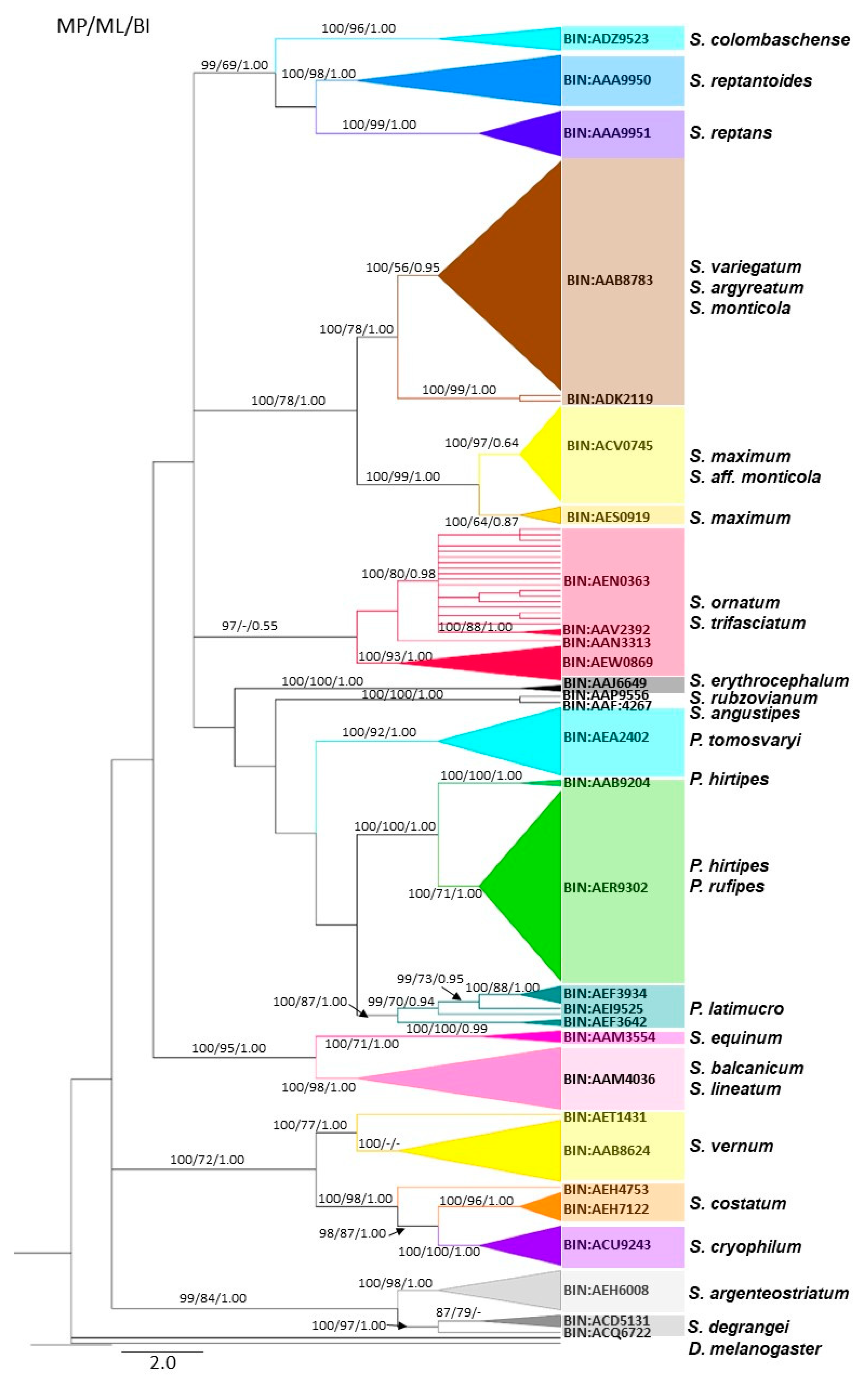
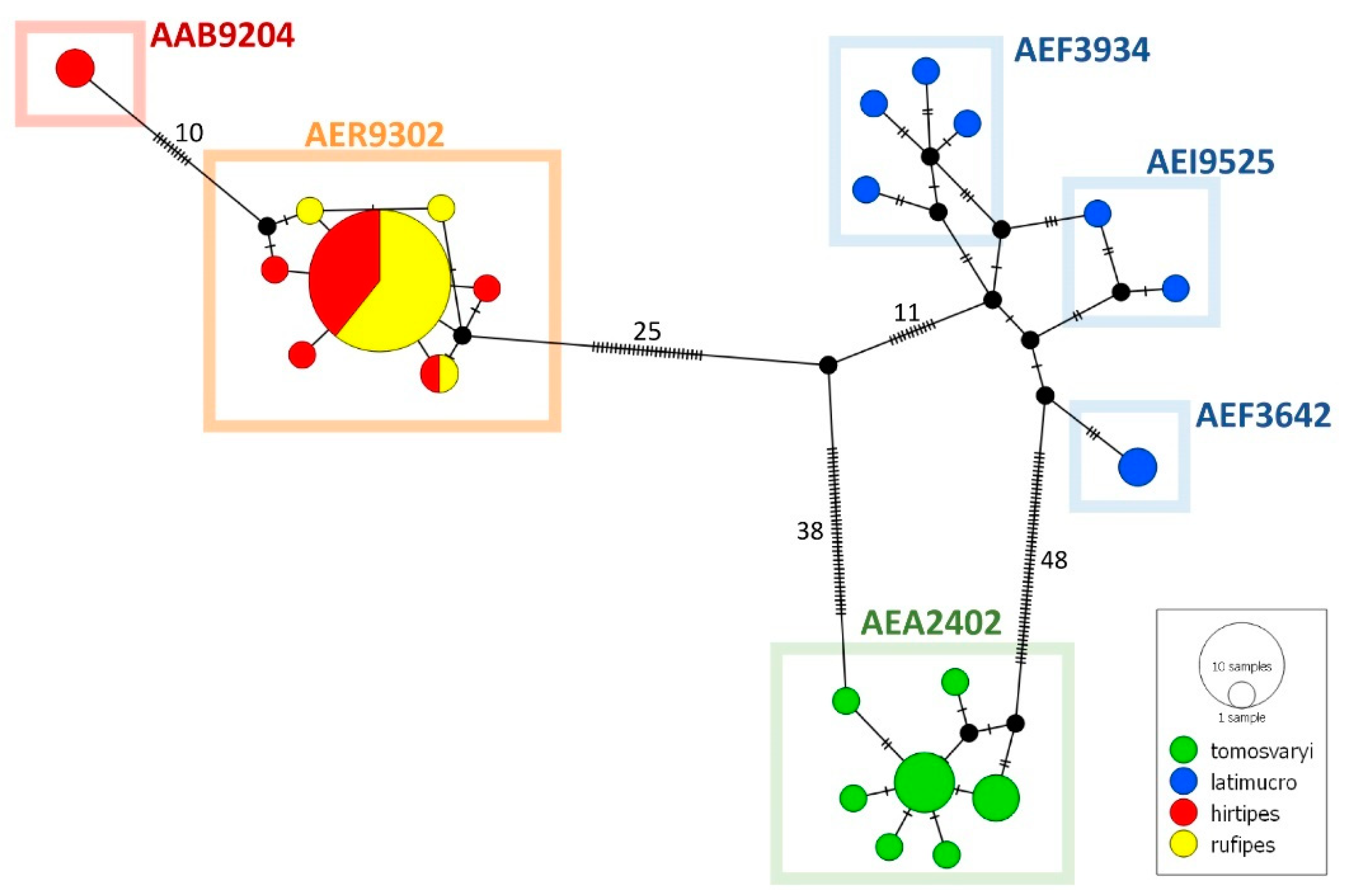
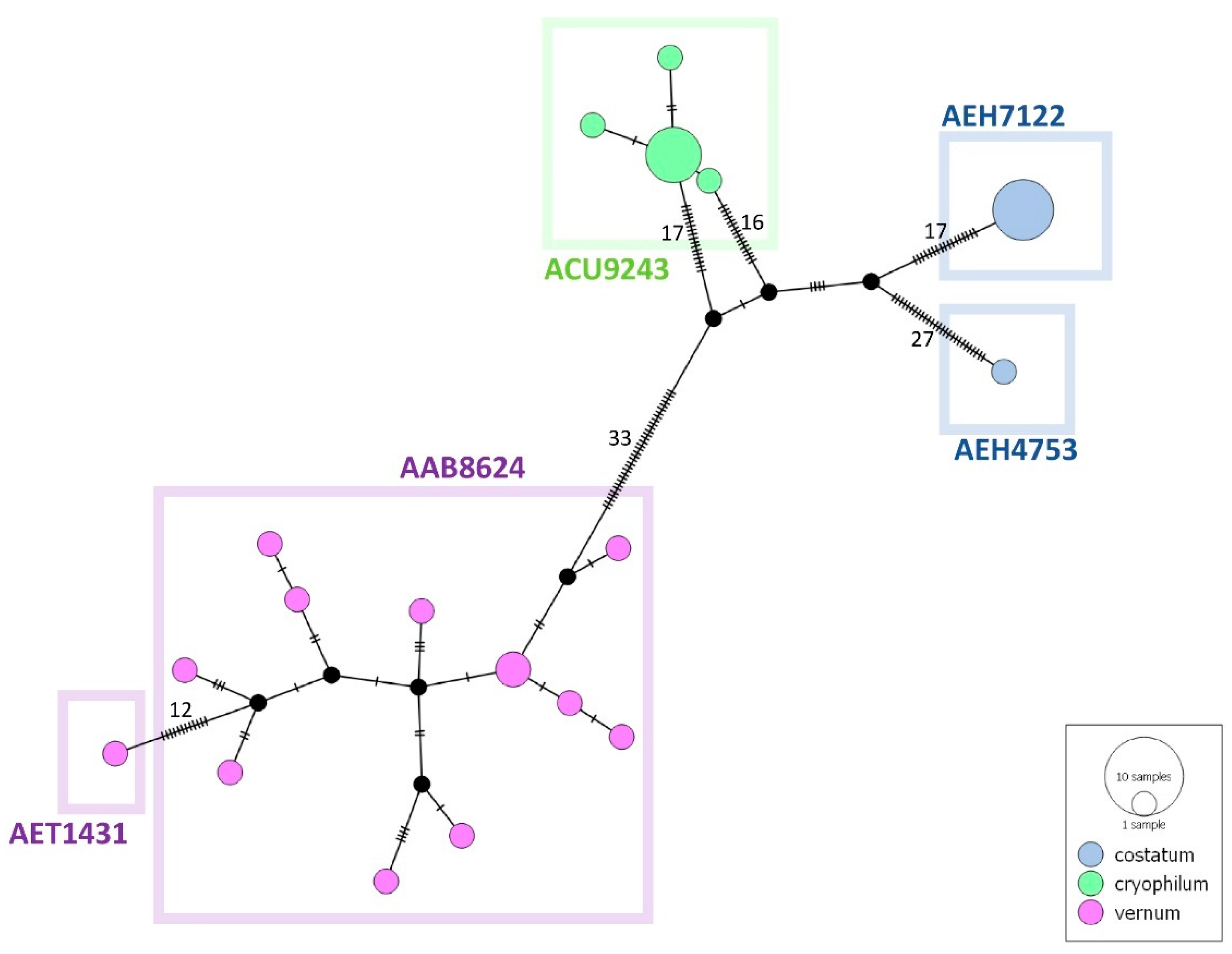
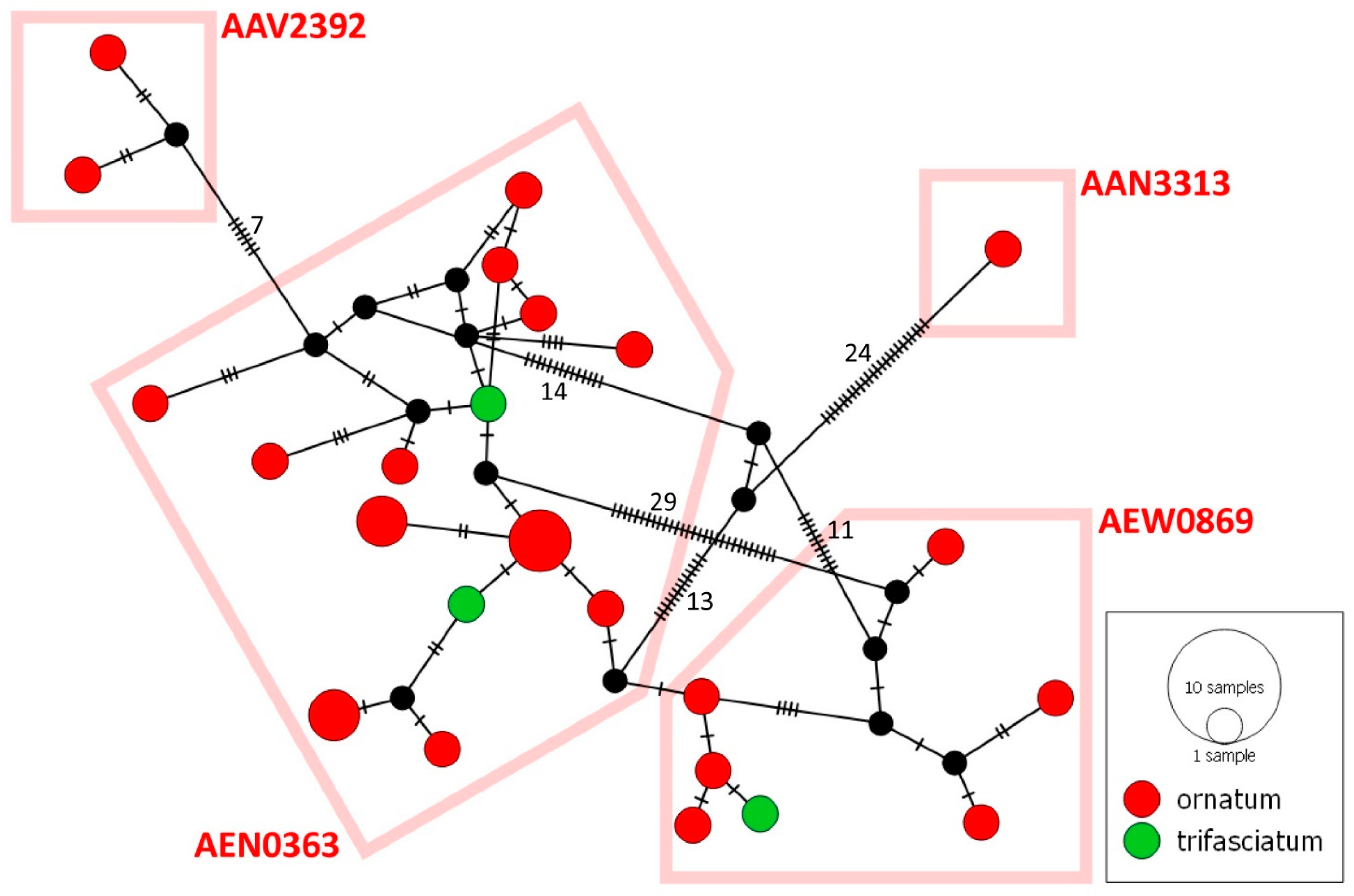

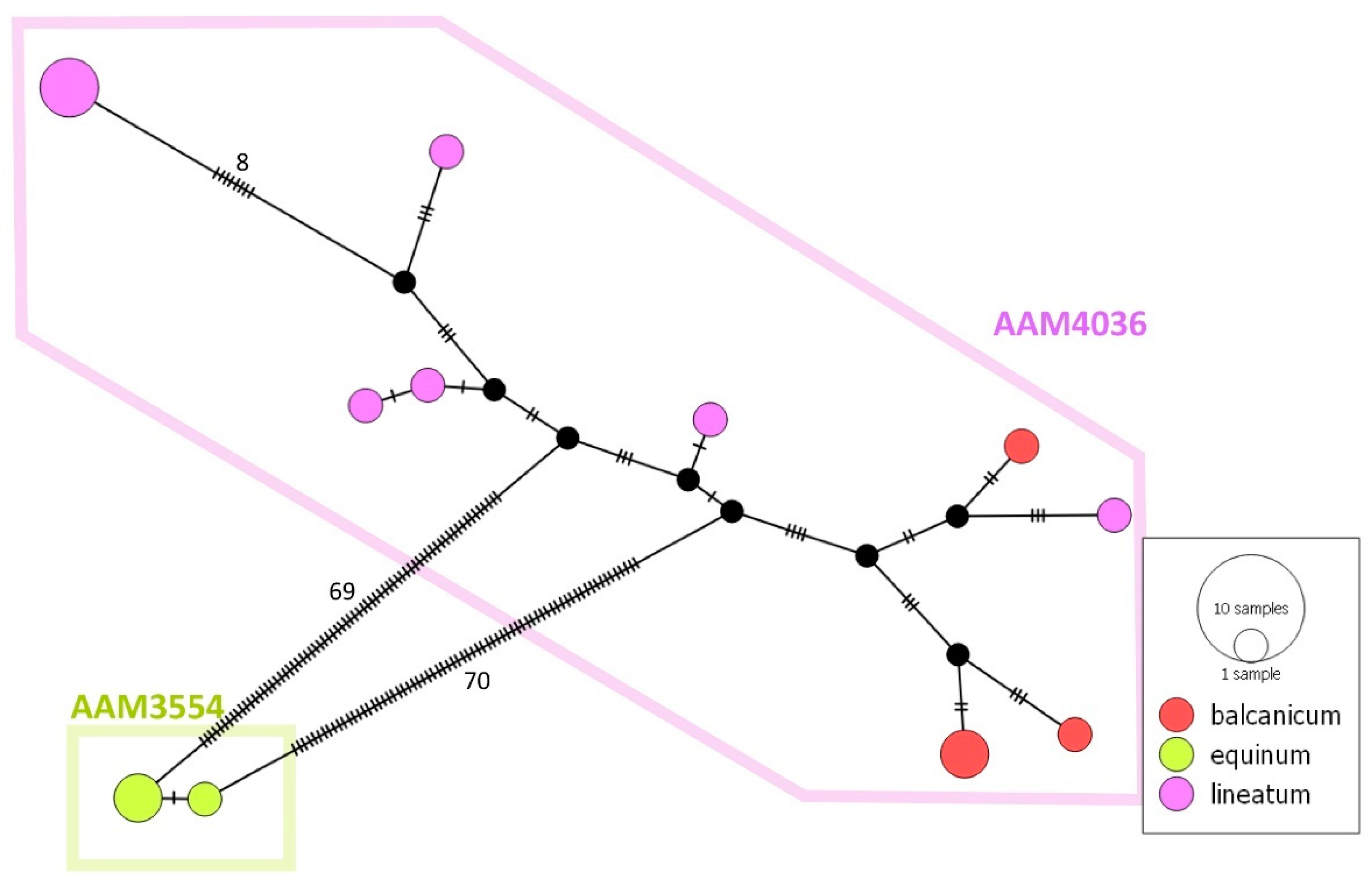
| Species | BIN | N |
Locality Waterbody, Municipality |
Coordinates N, E | Date | No. of Specimen (Per Date) |
|---|---|---|---|---|---|---|
| Prosimulium hirtipes (Fries, 1824) | AER9302 | 7 | 1 Čierny potok, Dolný Harmanec | 48.8201, 19.0342 | 1 May 2021 11 May 2021 10 June 2021 | 4 2 1 |
| 1 | 2 Kamenný potok, Častá | 48.3940, 17.3037 | 24 April 2021 | 1 | ||
| 7 | 3 Potok Račková, Pribylina | 49.1055, 19.8069 | 11 May 2021 10 June 2021 | 2 5 | ||
| AAB9204 | 2 | 1 Čierny potok, Dolný Harmanec | 48.8201, 19.0342 | 11 May 2021 10 June 2021 | 1 1 | |
| Prosimulium latimucro (Enderlein, 1925) | AEF3934 | 1 | 4 Malé Žabie Javorové pleso, Tatranská Javorina | 49.2023, 20.1500 | 14 September 2009 | 1 |
| 1 | 5 Prostredné Spišské pleso, Vysoké Tatry | 49.1910, 20.1972 | 12 August 2009 | 1 | ||
| 2 | 6 Malé Spišské pleso, Vysoké Tatry | 49.1901, 20.2004 | 12 August 2009 | 2 | ||
| AEI9525 * | 2 | 6 Malé Spišské pleso, Vysoké Tatry | 49.1901, 20.2004 | 12 August, 2009 | 2 | |
| AEF3642 | 2 | 6 Malé Spišské pleso, Vysoké Tatry | 49.1901, 20.2004 | 12 August 2009 | 2 | |
| Prosimulium rufipes (Meigen, 1830) | AER9302 | 11 | 1 Čierny potok, Dolný Harmanec | 48.8201, 19.0342 | 1 May 2021 11 May 2021 10 June 2021 | 3 6 2 |
| 9 | 3 Potok Račková, Pribylina | 49.1055, 19.8069 | 11 May 2021 10 June 2021 | 2 7 | ||
| Prosimulium tomosvaryi (Enderlein, 1921) | AEA2402 | 2 | 1 Čierny potok, Dolný Harmanec | 48.8201, 19.0342 | 1 May 2021 | 2 |
| 4 | 7 Drieňovka, Bratislava-Nové Mesto | 48.1877, 17.1234 | 5 May 2021 | 4 | ||
| 3 | 2 Kamenný potok, Častá | 48.3940, 17.3037 | 24 April 2021 | 3 | ||
| 4 | 8 Závada, Kšinná | 48.8302, 18.3631 | 1 April 2017 | 4 | ||
| Simulium erythrocephalum (De Geer, 1776) | AAJ6649 | 2 | 9 Vojčianske rameno, Kyselica | 47.9751, 17.3702 | 16 September 2020 | 2 |
| Simulium angustipes Edwards, 1915 | AAF4267 | 1 | 10 Bíňovce | 48.5092, 17.4772 | 6 March 2022 | 1 |
| Simulium rubzovianum (Sherban, 1961) | AAP9556 | 1 | 13 Hydina, Uhrovec (Látkovce) | 48.6929, 18.3499 | 1 April 2017 | 5 |
| Simulium costatum Friederichs, 1920 | AEH7122 * | 6 | 12 Sučiansky potok, Nitrianske Sučany | 48.7431, 18.4564 | 1 April 2017 | 6 |
| AEH4753 | 1 | 12 Sučiansky potok, Nitrianske Sučany | 48.7431, 18.4564 | 1 April 2017 | 1 | |
| Simulium cryophilum (Rubtsov, 1959) | ACU9243 | 5 | 13 Hydina, Uhrovec (Látkovce) | 48.6929, 18.3499 | 1 April 2017 | 5 |
| 3 | 14 Vríca, Vrícko | 48.9764, 18.6875 | 12 September 2020 | 3 | ||
| Simulium vernum Macquart, 1826 | AAB8624 | 1 | 7 Drieňovka, Bratislava-Nové Mesto | 48.1877, 17.1234 | 21 March 2022 | 1 |
| 1 | 13 Hydina, Uhrovec (Látkovce) | 48.6929, 18.3499 | 1 April 2017 | 1 | ||
| 4 | 15 Struha, Bratislava-Vajnory | 48.2258, 17.1815 | 21 March 2022 | 4 | ||
| 6 | 12 Sučiansky potok, Nitrianske Sučany | 48.7431, 18.4564 | 19 May 2018 | 6 | ||
| AET1431 | 1 | 15 Struha, Bratislava-Vajnory | 48.2258, 17.1815 | 21 March 2022 | 1 | |
| Simulium argenteostriatum Strobl, 1898 | AEH6008 * | 8 | 3 Potok Račková, Pribylina | 49.1055, 19.8069 | 17 July 2019 | 8 |
| Simulium degrangei Dorier & Grenier, 1960 | ACD5131 | 3 | 16 Belá, Liptovský Hrádok | 49.0448, 19.7227 | 13 June 2013 | 3 |
| ACQ6722 | 1 | 16 Belá, Liptovský Hrádok | 49.0448, 19.7227 | 13 June 2013 | 1 | |
| Simuium ornatum Meigen, 1818 | AEN0363 | 1 | 17 Dunaj, Bratislava-Devín | 48.1681, 16.9873 | 18 March 2022 | 1 |
| 3 | 11 Nitrica, Diviacka Nová Ves | 48.7339, 18.4993 | 27 July 2017 | 3 | ||
| 2 | 18 Nitrica, Liešťany (Lomnica) | 48.8436, 18.4701 | 27 July 2017 | 2 | ||
| 5 | 19 Striebornica, Uhrovec | 48.7530, 18.3625 | 20 September 2017 | 5 | ||
| 2 | 20 Váh, Liptovský Hrádok | 49.0349, 19.7112 | 13 June 2013 | 2 | ||
| 3 | 14 Vríca, Vrícko | 48.9764, 18.6875 | 12 September 2020 | 3 | ||
| AEW0869 | 5 | 21 Rudava, Veľké Leváre | 48.4888, 17.0096 | 25 September 2020 | 5 | |
| 1 | 19 Striebornica, Uhrovec | 48.7530, 18.3625 | 20 September 2017 | 1 | ||
| AAV2392 | 1 | 11 Nitrica, Diviacka Nová Ves | 48.7339, 18.4993 | 27 July 2017 | 1 | |
| 1 | 20 Váh, Liptovský Hrádok | 49.0349, 19.7112 | 13 June 2013 | 1 | ||
| AAN3313 | 1 | 20 Váh, Liptovský Hrádok | 49.0349, 19.7112 | 13 June 2013 | 1 | |
| Simulium trifasciatum Curtis, 1839 | AEN0363 | 2 | 19 Striebornica, Uhrovec | 48.7530, 18.3625 | 20 September 2017 | 2 |
| AEW0869 | 1 | 19 Striebornica, Uhrovec | 48.7530, 18.3625 | 20 September 2017 | 1 | |
| Simulium colombaschense (Scopoli, 1780) | ADZ9523 * | 5 | 22 Dunaj, Medveďov | 47.7887, 17.6651 | 16 May 2013 | 5 |
| Simulium reptans (Linnaeus, 1758) | AAA9951 | 9 | 23 Morava, Vysoká pri Morave | 48.3219, 16.9081 | 30 April 2013 | 9 |
| Simulium reptantoides Carlsson, 1962 | AAA9950 | 7 | 24 Váh, Ivachnová | 49.0960, 19.4118 | 19 July 2014 | 7 |
| 3 | 16 Belá, Liptovský Hrádok | 49.0448, 19.7227 | 19 July 2014 | 3 | ||
| Simulium argyreatum Meigen, 1838 | AAB8783 | 7 | 1 Čierny potok, Dolný Harmanec | 48.8201, 19.0342 | 1 May 2021 | 7 |
| 3 | 25 Podhradský potok, Zliechov | 48.9699, 18.3714 | 30 June 2018 | 3 | ||
| 3 | 3 Potok Račková, Pribylina | 49.1055, 19.8069 | 17 July 2019 | 3 | ||
| ADK2119 | 2 | 1 Čierny potok, Dolný Harmanec | 48.8201, 19.0342 | 1 May 2021 | 2 | |
| Simulium maximum (Knoz, 1961) | ACV0745 | 4 | 3 Potok Račková, Pribylina | 49.1055, 19.8069 | 10 June 2021 | 4 |
| AES0919 * | 4 | 3 Potok Račková, Pribylina | 49.1055, 19.8069 | 10 June 2021 | 4 | |
| Simulium monticola Friederichs, 1920 | AAB8783 | 14 | 1 Čierny potok, Dolný Harmanec | 48.8201, 19.0342 | 24 September 2020 1 May 2021 | 6 8 |
| Simulium sp. aff. monticola | ACV0745 | 14 | 1 Čierny potok, Dolný Harmanec | 48.8201, 19.0342 | 24 September 2020 1 May 2021 | 4 10 |
| Simulium variegatum Meigen, 1818 | AAB8783 | 6 | 25 Podhradský potok, Zliechov | 48.9699, 18.3714 | 30 June 2018 | 6 |
| 9 | 3 Potok Račková, Pribylina | 49.1055, 19.8069 | 17 July 2019 | 9 | ||
| Simulium balcanicum (Enderlein, 1924) | AAM4036 | 4 | 26 Priesakový kanál, Bratislava-Rusovce | 48.0729, 17.1395 | 23 March 2019 | 4 |
| Simulium equinum (Linnaeus, 1758) | AAM3554 | 3 | 11 Nitrica, Diviacka Nová Ves | 48.7339, 18.4993 | 27 July 2017 | 3 |
| Simulium lineatum (Meigen, 1804) | AAM4036 | 1 | 17 Dunaj, Bratislava-Devín | 48.1681, 16.9873 | 18 March 2022 | 1 |
| 7 | 11 Nitrica, Diviacka Nová Ves | 48.7339, 18.4993 | 27 July 2017 | 7 |
| Species | n | Intraspecific Genetic Distances | Interspecific Genetic Distances | ||||||
|---|---|---|---|---|---|---|---|---|---|
| Min | Max | Average | Std | Min | Max | Average | Std | ||
| P. hirtipes * | 17 | 0.0000 | 0.0195 | 0.0047 | 0.0072 | 0.0000 | 0.1187 | 0.0508 | 0.0491 |
| P. latimucro | 8 | 0.0000 | 0.0364 | 0.0181 | 0.0122 | 0.0678 | 0.0997 | 0.0777 | 0.0099 |
| P. rufipes * | 20 | 0.0000 | 0.0048 | 0.0006 | 0.0011 | 0.0000 | 0.1147 | 0.0543 | 0.0487 |
| P. tomosvaryi | 13 | 0.0000 | 0.0064 | 0.0023 | 0.0016 | 0.0886 | 0.1187 | 0.1080 | 0.0071 |
| S. erythrocephalum | 2 | 0.0032 | 0.0032 | 0.0032 | 0.0000 | 0.1184 | 0.1880 | 0.1429 | 0.0175 |
| S. angustipes | 1 | N/A | N/A | N/A | N/A | 0.0765 | 0.1942 | 0.1580 | 0.0149 |
| S. rubzovianum | 1 | N/A | N/A | N/A | N/A | 0.0765 | 0.1914 | 0.1645 | 0.0132 |
| S. costatum * | 7 | 0.0000 | 0.0713 | 0.0225 | 0.0336 | 0.0586 | 0.2028 | 0.1453 | 0.0253 |
| S. cryophilum | 8 | 0.0000 | 0.0048 | 0.0016 | 0.0015 | 0.0586 | 0.1942 | 0.1518 | 0.0279 |
| S. vernum | 13 | 0.0000 | 0.0312 | 0.0117 | 0.0070 | 0.0877 | 0.1815 | 0.1443 | 0.0196 |
| S. argenteostriatum | 8 | 0.0016 | 0.0146 | 0.0058 | 0.0036 | 0.0977 | 0.1814 | 0.1429 | 0.0125 |
| S. degrangei | 4 | 0.0000 | 0.0163 | 0.0092 | 0.0065 | 0.0977 | 0.1834 | 0.1458 | 0.0144 |
| S. ornatum * | 25 | 0.0000 | 0.0779 | 0.0324 | 0.0246 | 0.0000 | 0.1923 | 0.1275 | 0.0236 |
| S. trifasciatum * | 3 | 0.0048 | 0.0567 | 0.0139 | 0.0268 | 0.0000 | 0.1858 | 0.1139 | 0.0399 |
| S. colombaschense | 5 | 0.0016 | 0.0032 | 0.0026 | 0.0008 | 0.0670 | 0.1585 | 0.1239 | 0.0205 |
| S. reptans | 9 | 0.0000 | 0.0130 | 0.0032 | 0.0047 | 0.0600 | 0.1665 | 0.1164 | 0.0219 |
| S. reptantoides | 10 | 0.0000 | 0.0130 | 0.0067 | 0.0044 | 0.0600 | 0.1731 | 0.1234 | 0.0218 |
| S. argyreatum * | 15 | 0.0000 | 0.0415 | 0.0143 | 0.0142 | 0.0000 | 0.1921 | 0.1049 | 0.0530 |
| S. maximum * | 8 | 0.0000 | 0.0163 | 0.0088 | 0.0073 | 0.0000 | 0.2006 | 0.1106 | 0.0483 |
| S. monticola * | 14 | 0.0000 | 0.0081 | 0.0034 | 0.0023 | 0.0000 | 0.1984 | 0.1042 | 0.0536 |
| S. sp. aff. monticola * | 14 | 0.0000 | 0.0000 | 0.0000 | 0.0000 | 0.0000 | 0.1984 | 0.1149 | 0.0447 |
| S. variegatum * | 15 | 0.0000 | 0.0113 | 0.0055 | 0.0024 | 0.0000 | 0.1898 | 0.1040 | 0.0531 |
| S. balcanicum * | 4 | 0.0000 | 0.0163 | 0.0103 | 0.0059 | 0.0081 | 0.1808 | 0.1500 | 0.0295 |
| S. equinum | 3 | 0.0000 | 0.0016 | 0.0011 | 0.0008 | 0.1167 | 0.2028 | 0.1777 | 0.0185 |
| S. lineatum * | 8 | 0.0000 | 0.0296 | 0.0172 | 0.0088 | 0.0081 | 0.1813 | 0.1518 | 0.0229 |
Disclaimer/Publisher’s Note: The statements, opinions and data contained in all publications are solely those of the individual author(s) and contributor(s) and not of MDPI and/or the editor(s). MDPI and/or the editor(s) disclaim responsibility for any injury to people or property resulting from any ideas, methods, instructions or products referred to in the content. |
© 2023 by the authors. Licensee MDPI, Basel, Switzerland. This article is an open access article distributed under the terms and conditions of the Creative Commons Attribution (CC BY) license (https://creativecommons.org/licenses/by/4.0/).
Share and Cite
Kúdelová, T.; Krčmárik, S.; Lužáková, I.; Bujačková, B.; Matická, K.; Kúdela, M. DNA Barcoding of Black Flies (Diptera: Simuliidae) in Slovakia and Its Utility for Species Identification. Diversity 2023, 15, 661. https://doi.org/10.3390/d15050661
Kúdelová T, Krčmárik S, Lužáková I, Bujačková B, Matická K, Kúdela M. DNA Barcoding of Black Flies (Diptera: Simuliidae) in Slovakia and Its Utility for Species Identification. Diversity. 2023; 15(5):661. https://doi.org/10.3390/d15050661
Chicago/Turabian StyleKúdelová, Tatiana, Samuel Krčmárik, Ivona Lužáková, Bibiana Bujačková, Karin Matická, and Matúš Kúdela. 2023. "DNA Barcoding of Black Flies (Diptera: Simuliidae) in Slovakia and Its Utility for Species Identification" Diversity 15, no. 5: 661. https://doi.org/10.3390/d15050661
APA StyleKúdelová, T., Krčmárik, S., Lužáková, I., Bujačková, B., Matická, K., & Kúdela, M. (2023). DNA Barcoding of Black Flies (Diptera: Simuliidae) in Slovakia and Its Utility for Species Identification. Diversity, 15(5), 661. https://doi.org/10.3390/d15050661







